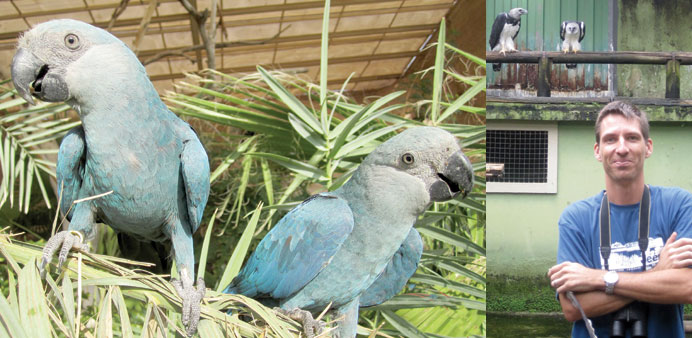SPECTACULAR: Two young Spix’s Macaw. Photos of the birds and habitat by The Al Wabra Foundation. right; EXPERT: Five chicks were successfully hatched in 2012, seven the following year, and this year so far three chicks have hatched and there are another two fertile eggs, according to Dr Cromwell Purchase, Head of Birds at the AWWP.
By Fran Gillespie
One of the world’s rarest birds is alive and well, and living in Qatar. In a recent lecture to members of the Qatar Natural History Group, Dr Cromwell Purchase, Head of Birds at the Al Wabra Wildlife Preservation (AWWP), gave his listeners the latest information on the ongoing efforts to prevent the Spix’s Macaw from becoming extinct.
The story of this large and spectacularly beautiful bright blue parrot, Cyanopsitta spixii, native to a semi-arid region of Northern Bahia State in Brazil, is a sad one, typical of the fate of so many parrots and macaws that have suffered from widespread trapping for the exotic pet trade.
The introduction of the aggressive Africanised bee, which competed for nest sites in holes in cliffs, stinging and killing breeding birds on their nests, also contributed to its decline. The species was feared to be extinct in the wild in the early 1980s, until it was rediscovered in 1985, when just five birds, including two pairs, were located in the north of Bahia State. But there have been no sightings in the wild since a solitary male bird was recorded in October 2000.
The only hope for the species’ survival was to breed from the few birds that were in captivity around the world. The owner of Al Wabra, Sheikh Saoud bin Mohammed bin Ali al-Thani, set about buying a number from private collections in the Philippines and Switzerland, and a breeding programme to save the bird from total extinction was begun.
“Of the 89 birds in captivity worldwide,” said Dr Purchase, “We now have 69 at Al Wabra. Five chicks were successfully hatched in 2012, seven the following year, and this year so far three chicks have hatched and there are another two fertile eggs.”
Breeding from such a small gene pool of captive birds, probably all descended from a few individuals, is fraught with problems. There is the occasional misshapen egg, chicks sometimes fail to hatch, and there are behavioural problems. Genetic research is ongoing.
Fertile eggs are not left to the parent birds to hatch but are carefully placed in incubators and constantly monitored. AWWP’s bird nursery has three rooms exclusively for Spix’s Macaws — one for incubation, another for hand-rearing and a room for the fledglings, including a 10-metre-long flight aviary. As soon as the chicks are old enough they are allowed to flock together, to learn skills from each other that are vital for their survival in the wild.
The ultimate aim of this very expensive programme is to return Spix’s Macaws to their native habitat. In 2008 the 2380-hectare Concordia Farm in north-eastern Brazil was purchased, as an area for the future release of the birds. Located in Bahia State in the district of Curaca, Concordia Farm is within the former range of the Spix’s Macaw.
The last recorded sighting of the bird in the wild was amongst the Caraibeira trees lining a creek that flows through the property. Removal of domestic live stock is allowing the area to gradually return to its natural state, and efforts to encourage the growth of the trees that the birds like to feed on have been successful.
“Work is in progress,” said Dr Purchase, “with the Brazilian government to acquire still more land as suitable habitat for the macaws.”
However, the release project has little chance of succeeding in the long term unless local people are helped to understand why it is important to protect the macaws. Funds were provided to set up a local school, and the students are given an environmental education programme. When the birds are released, the rangers that monitor their progress will be recruited locally.
Founded by Sheikh Saoud bin Mohammed on land that was formerly an estate owned by his family, the AWWP is a breeding and research centre not only for the high-profile Spix’s Macaws but also for some of the world’s rarest and most endangered species of birds and mammals.
It has achieved pioneering success in the captive propagation and research of a number of highly endangered species including the Lear’s Macaw, the Somali Wildass and Birds of Paradise, of which it has the largest breeding collection in the world, recently filmed by BBC 2.
The speaker at the meeting on June 4 of the Qatar Natural History Group, the last of the 2013/14 season, will be the architect Tim Makower. Details on www.qnhg.org

